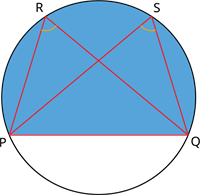
PUMPA - SMART LEARNING
எங்கள் ஆசிரியர்களுடன் 1-ஆன்-1 ஆலோசனை நேரத்தைப் பெறுங்கள். டாப்பர் ஆவதற்கு நாங்கள் பயிற்சி அளிப்போம்
Book Free DemoAngles at the circumference to the same segment
Illustration:
Consider a circle with centre O and chord PQ.
Let R and S be any two points on the circumference of the circle lying on the same segment of the circle.
Join the endpoints of the chord PQ with the centre O.

We know that, according to the theorem, the angle subtended by an arc of the circle at the centre is double the angle subtended by it at any point on the remaining part of the circle.
This implies, \frac{1}{2} \angle POQ = \angle PRQ …… \text{equation }(1)
Similarly, \frac{1}{2} \angle POQ = \angle PSQ …… \text{equation }(2)
From equation (1) and (2), we have:
\angle PRQ = \angle PSQ
Based on this result, the following theorem is obtained.
Theorem: Angles in the same segment of a circle are equal.
Explanation:

The theorem states that angles in the same segment of the circle are equal. In the given circle, the angles \angle PRQ and \angle PSQ are equal as they lie on the same segment (i.e.) \angle PRQ = \angle PSQ.
Example:
Find the unknown angles x and y in the given figure, where O is the centre of the circle.

Solution:
According to the theorem, the angle subtended by an arc of the circle at the centre is double the angle subtended by it at any point on the remaining part of the circle.
This implies:
\angle PRQ = \frac{1}{2} \angle POQ
x = \frac{1}{2} \times 120^{\circ}
= 60^{\circ}
Also, by the theorem, angles in the same segment of a circle are equal.
Hence, \angle PRQ = \angle PSQ.
So, x = y.
Therefore, y = 60^{\circ}.
Important!
The converse of the theorem is also true, which states
If a line segment joining two points subtends equal angles at two other points lying on the same side of the line containing the line segment, the four points lie on a circle (i.e. they are concyclic).
Explanation:

The theorem states that if the line segment PQ subtends equal angles at the points R and S on the same side of the line containing the segment PQ then the four points P, Q, R and S lie on the circle.